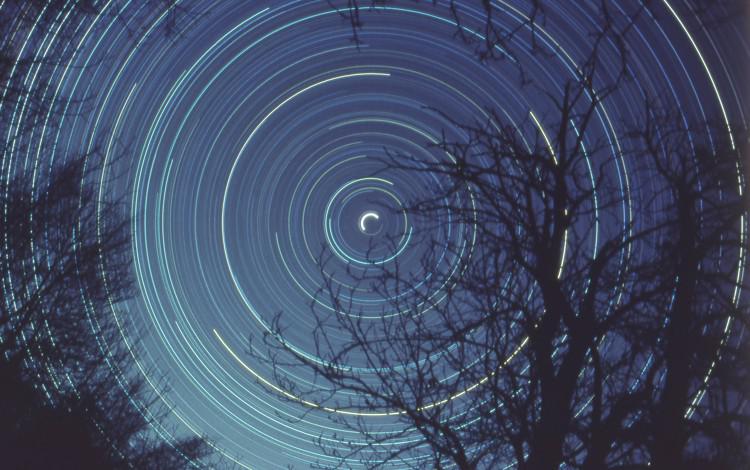This page describes an image Esposizione di mezza giornata alla stella polare, di Fabrizio Melandri, Italia
Didascalia:
Primo posto al concorso di astrofotografia IAU OAE, categoria Scie stellari.
Questa immagine della scia stellare mostra il movimento apparente delle stelle nel cielo notturno, che deriva dalla rotazione della Terra attorno al suo asse polare. Gli alberi in primo piano fungono da ancora mentre ruotiamo con la Terra. Il luminoso semicerchio bianco al centro dell'immagine è la stella Polare, che si trova molto vicina al Polo Nord Celeste. Immaginando che la Terra sia al centro di una sfera di cristallo cava e che le stelle siano incastonate in questa sfera, mentre la Terra ruota sul suo asse, un osservatore sulla Terra vede le stelle sorgere e tramontare seguendo un arco, perché l'orizzonte impedisce all'osservatore di vedere l'arco completo delle stelle più lontane dal Polo Celeste. Il Polo Nord Celeste (e il suo opposto, il Polo Sud Celeste) si forma essenzialmente prolungando la linea dell'asse terrestre. Per catturare questa immagine è necessario che il fotografo effettui una lunga esposizione con la fotocamera su un treppiede, puntata verso la Stella Polare (Emisfero Nord). Nell'emisfero australe non c'è una stella così vicina al Polo Celeste come la stella Polare, quindi la posizione del Polo Celeste Sud viene individuata utilizzando la Croce del Sud e le stelle puntatrici (Alfa e Beta Centauri). Sebbene nel complesso l'immagine abbia una leggera sfumatura blu, essa cattura i diversi colori delle stelle; è facile distinguere tra le stelle blu a temperatura più elevata e le stelle biancastre a temperatura più bassa, e le stelle rossastre a temperatura ancora più bassa. La ragione di questa variazione di colore è che le stelle a temperatura più alta emettono maggiormente in lunghezze d'onda più corte (più blu), rispetto alle stelle a temperatura più bassa che emettono in lunghezze d'onda più lunghe (più rosse).
Crediti:
Fabrizio Melandri/IAU OAE
Stato di traduzione della didascalia: Approvato da un revisore
traduttori della didascalia: Giuliana Giobbi
revisori della didascalia: Silvia Casu, Rodolfo Canestrari
DOI: 10.5281/zenodo.5371231
Termini di glossario connessi:
Scia stellare
, Stelle circumpolari
Licenza: Creative Commons Attribuzione 4.0 Internazionale (CC BY 4.0) Creative Commons Attribuzione 4.0 Internazionale (CC BY 4.0) icone
Didascalie in lingue diverse:
Didascalia: First place in the IAU OAE Astrophotography Contest, category Star trails.
This star trail image shows the apparent movement of the stars in the night sky, which results from the Earth’s rotation around its polar axis. The trees in the foreground serve as an anchor as we turn with the Earth. The bright white semi-circle in the center of the image is the North (Pole) star – Polaris, which is located very close to the North Celestial Pole. One way to imagine that the Earth is at center of hollow crystal sphere, and the stars are embedded on this sphere, as the Earth spins on its axis, an observer on Earth sees the stars rising and setting, following an arc, because the horizon prevents the observer from the full arc for stars that are further away from the Celestial Pole. The North Celestial Pole (and its opposite the South Celestial Pole) is essentially formed by extending the line of the Earth’s axis. Capturing this image requires the photographer to take a long exposure with the camera on a tripod and pointing towards the Pole Star (North Hemisphere). In the Southern Hemisphere there is no star as close as Polaris is to the Celestial Pole, so the position of the South Celestial Pole is found using the South Cross and Pointer Stars (Alpha and Beta Centauri). Although overall the image has a slight blue tint, it does capture the varying colours of stars, it is easy to distinguish between the higher temperature blue stars and the lower temperature of the whitish stars, and even lower temperature reddish stars. The reason for this variation in colour is because higher temperature stars emit more in shorter wavelengths (bluer), compared to lower temperature stars which emit in longer wavelengths (redder).
Crediti: Fabrizio Melandri/IAU OAE
Termini di glossario connessi: Circumpolar Stars , Star Trail









